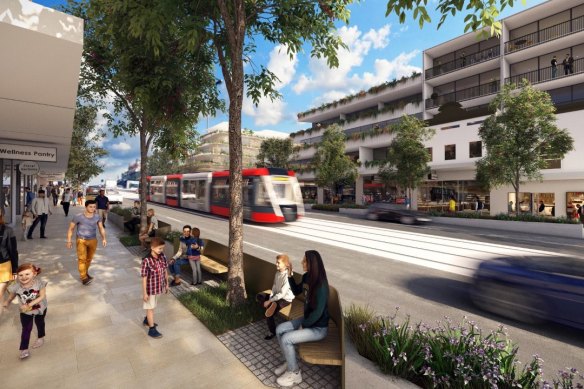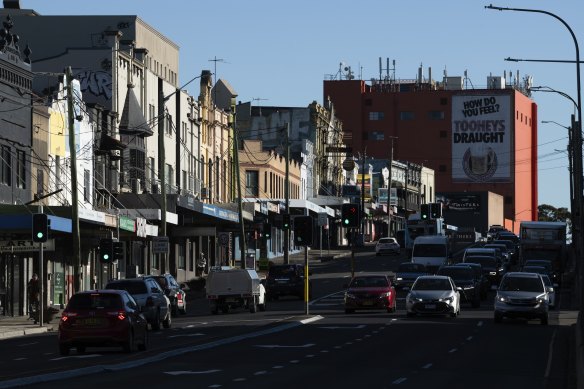This was published 3 months ago
Why light rail would turn Parramatta Road into the next George Street
By Megan Gorrey
Plans to run light rail down Parramatta Road could mirror the transformation of George Street in Sydney’s CBD, opening up the strip for pedestrians and attracting billions of dollars in investment.
That’s the view of City of Sydney Lord Mayor Clover Moore, who said the long-vaunted ambition to turn the congested strip into a pedestrian-friendly, tree-lined boulevard with light rail and fewer lanes for cars often stoked scepticism.

An artist’s impression of the proposed light-rail line along Parramatta Road.
But it is “a project whose time has come”, and “the stars are now aligned, with state and federal support”, Moore told a Parramatta Road summit run by the Committee for Sydney on Wednesday.
“People also said George Street would never happen. And whilst Parramatta Road is not George Street, it can be as fantastic. George Street attracted $8 billion worth of investment over the last four years,” Moore said.
“Improving the public domain and taking noisy polluting buses off Parramatta Road will attract investment in new housing close to jobs, transport infrastructure and services, which as we know is urgently needed.”
In June, the ALTRAC consortium that built Sydney’s light-rail network revealed a proposal for an 11-kilometre line along Parramatta Road to Central Station and on to Green Square in the inner south.
The line, which would have about 21 stops, would run from an existing stop at Taverners Hill, along Parramatta Road and Broadway to Central, and then through Redfern and Waterloo to Green Square.
The project – which the summit heard has the backing of the City of Sydney Council, the Inner West Council, and Burwood Council – would still include two lanes for cars running in each direction.
Inner West Council Mayor Darcy Byrne agreed the corridor needed a “major public transport injection” but said changes would also require incentives for property owners and developers.
“In the past six or seven years, we’ve carried out a number of [rezonings that have not] resulted in redevelopment. I think we need to think again about the incentives all around for how we encourage occupancy and how we encourage amalgamation of land so that it can be redeveloped,” he said.

Vacant buildings on Parramatta Road at Croydon. The corridor is earmarked for more intensive residential development.Credit: Kate Geraghty
Burwood Mayor John Faker said, “the time is now” for the light rail line, even if it was unpopular.
“I think we’re going to get some opposition from people wanting to drive cars … but people just have to change their habits. You don’t need to always jump in a car, and we’re so close to the city,” he said.
“I doubted some of the changes with George Street when they were announced, but seeing it now, I think it’s a fantastic move, and I think we can have some replication of that along Parramatta Road.”
NSW Roads Minister John Graham told the summit the Minns government was reluctant to add another plan to the decades of failed visions and promises that had earned Parramatta Road its nickname as Sydney’s “boulevard of broken dreams”.
He said the government would instead focus on policies to boost housing supply, public and active transport and the 24-hour economy to transform the corridor.

The Minns government will focus on housing, government involvement, transport and “vibrancy” reforms to reinvent the corridor.Credit: Rhett Wyman
“We’ll also ask the question of local councils and the community whether creating a co-ordinating agency such as a development corporation is the best way to achieve that,” Graham said.
Byrne said he wasn’t opposed to the concept of a “Parramatta Road development authority” or similar, but Moore said it was unnecessary because the three councils already worked well together.
Faker agreed the councils “usually find the roadblocks within state [government] agencies”.
“Give us the resources. Let us do the work. We’ll come up with the master plan. We’ll come up with your funding models. We’ll have the vision, and then we’ll start working on that within our precincts,” he said.
Graham also told the summit that 495 bus mirrors had been smashed on sections of the road that were too narrow for two buses to go past each other side-by-side in the past six years. He joked the road had “also become a boulevard of broken mirrors – and it highlights the weakness of the current plan”.
ALTRAC Light Rail chairwoman Penny Graham said the proposed light-rail line would enable the construction of a 6.5-kilometre “ribbon of development” comprising a mix of housing types.
“The housing investment won’t hold off until light rail is built; it’ll come as soon as that announcement is made,” she said.
Start the day with a summary of the day’s most important and interesting stories, analysis and insights. Sign up for our Morning Edition newsletter.